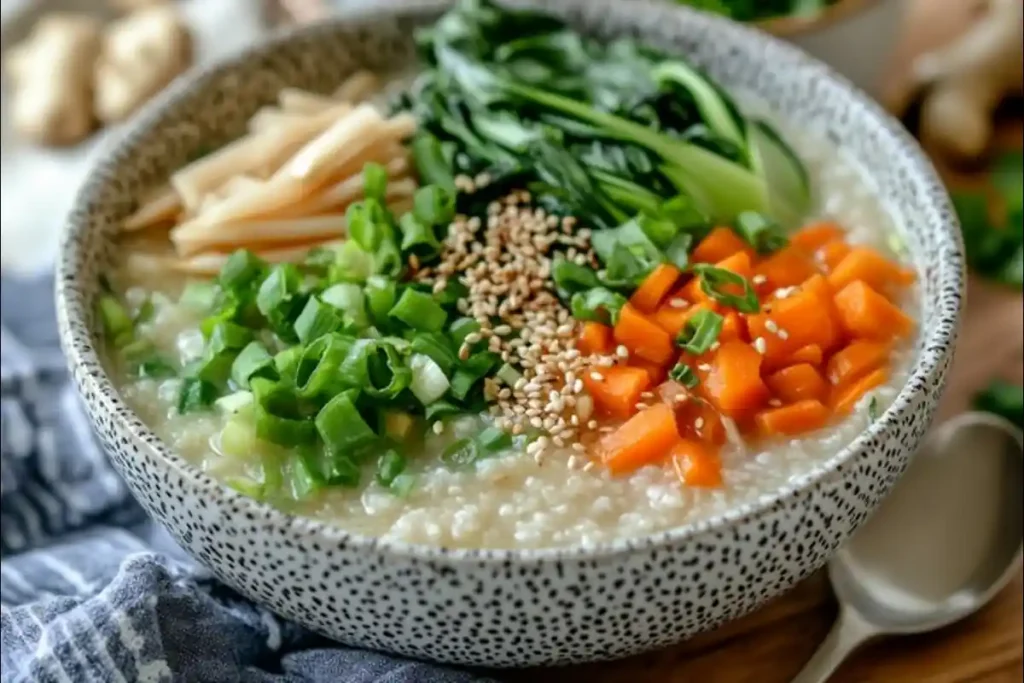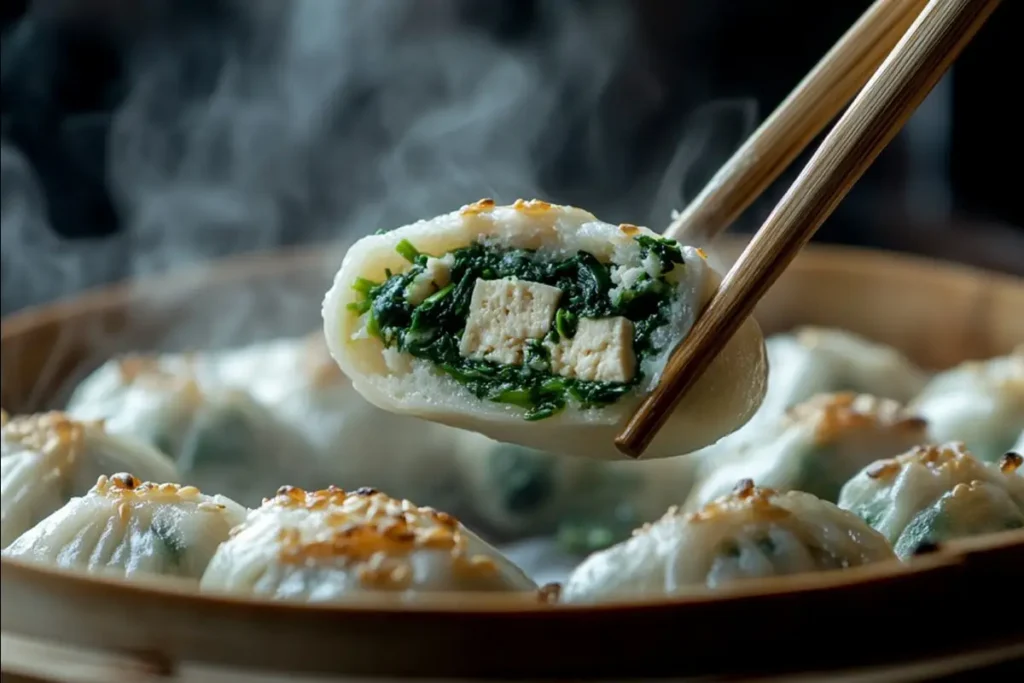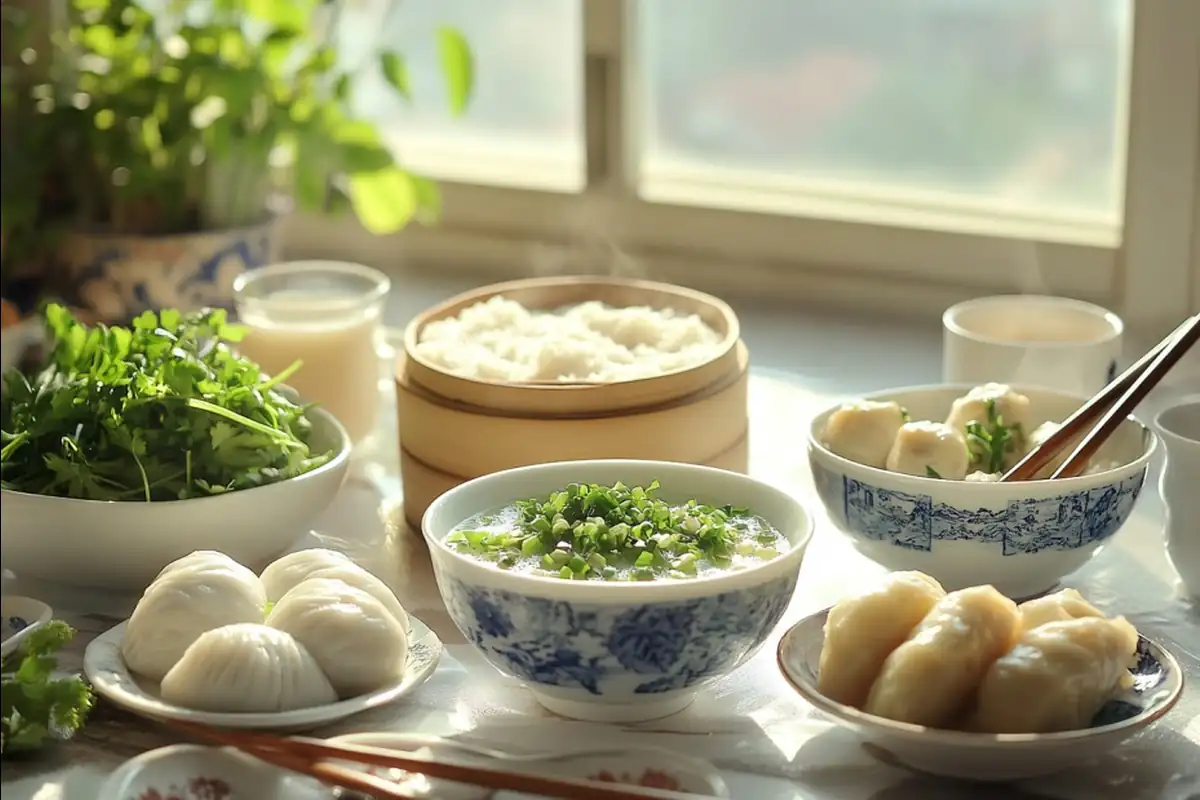Introduction
Breakfast is often called the most important meal of the day, and in Chinese culture, it’s a blend of nutrition, tradition, and balance. From steaming bowls of congee to soft, pillowy baozi, the variety of Chinese breakfast dishes reflects a deep respect for both health and flavor. This article delves into the fascinating world of Chinese breakfasts, exploring what is the healthiest Chinese breakfast, how to prepare it, and the ingredients that make it so wholesome. Whether you’re a food enthusiast or someone looking for healthier options, you’ll find inspiration to start your day on the right note.
1: Introduction to Healthy Chinese Breakfasts
Why Traditional Chinese Breakfasts Are Nutritious
In Chinese culture, breakfast isn’t just about eating; it’s about harmony and sustenance. Many traditional breakfasts are designed to provide energy for the day ahead while balancing flavors and nutrients. Unlike sugary cereals or fast food, Chinese breakfasts focus on whole foods, gentle cooking methods, and nutrient-rich ingredients like tofu, eggs, and vegetables.
Historically, breakfast was seen as a way to restore the body’s yin-yang balance. Ingredients were chosen not just for their taste but also for their effects on health. For instance, warm congee is believed to “warm the stomach,” while soybean milk replenishes energy.
Key Principles of a Healthy Chinese Breakfast
What makes a Chinese breakfast healthy? It’s the combination of fresh ingredients, mindful preparation, and balanced nutrition. Most dishes feature a mix of:
- Whole grains: Rice or wheat for sustained energy.
- Proteins: Tofu, eggs, or soy for muscle repair.
- Vegetables: Leafy greens or root vegetables for vitamins.
Moreover, steaming and boiling—rather than frying—are commonly used cooking methods to retain nutrients and reduce unhealthy fats. This approach keeps calorie counts low without sacrificing flavor.
Traditional vs. Modern Approaches to Breakfast in China
While traditional Chinese breakfasts are rooted in simplicity, modern lifestyles have introduced processed or convenience foods. But many urban dwellers are rediscovering traditional meals for their health benefits. For example, instead of deep-fried dough sticks (youtiao), people now opt for baked alternatives or pair them with unsweetened soybean milk to cut down on added sugars.
In today’s fast-paced world, it’s easier than ever to adapt these traditional dishes to fit modern diets. Whether you’re recreating classics like steamed buns or experimenting with new flavors, healthy Chinese breakfasts offer something for everyone.
2: Popular Healthy Chinese Breakfast Dishes
What Makes Soybean Milk and Dough Sticks a Healthy Choice?
A classic pairing, soybean milk (doujiang) and dough sticks (youtiao) are beloved across China. While traditionally deep-fried, modern recipes use baked or air-fried dough sticks to reduce calorie intake. Unsweetened soybean milk is a nutritional powerhouse, rich in protein and low in fat. Together, they offer a comforting start to the day while catering to modern health-conscious lifestyles.
To learn about creating perfect dough recipes for breakfast, you might explore detailed techniques here.
Steamed Buns (Baozi)
Steamed buns, or baozi, are a hallmark of Chinese breakfast culture. These soft, fluffy buns come filled with various ingredients, from lean meats to vegetable medleys. Healthier fillings, such as spinach, mushrooms, and tofu, are becoming increasingly popular. What makes baozi special is the steaming method, which retains nutrients while avoiding excess fat.
Rice Porridge (Congee)
Rice porridge, also known as congee, is a nutritional chameleon. Depending on the toppings, it can be light and simple or packed with nutrients. Popular healthy versions include:
- Vegetable congee with bok choy and carrots.
- Seafood congee enriched with omega-3-rich fish.
- Chicken congee for a protein boost.
Its gentle, warm nature makes congee an ideal option for those seeking to soothe the digestive system.
Wontons in Broth
Wontons are a delightful breakfast choice, especially when served in a light broth. Traditionally filled with shrimp or minced pork, modern versions now include vegetarian options like mushrooms and spinach. A bowl of wonton soup is not only comforting but also brimming with essential vitamins and minerals.
Rice Noodles and Pancakes
In southern China, rice noodles are a breakfast staple. These are typically served with fresh vegetables, light sauces, and lean proteins. Pancakes, such as scallion pancakes, are another popular choice. Opting for whole-grain flour and less oil during preparation transforms this dish into a healthier indulgence.
3: Ingredients That Define the Healthiest Chinese Breakfast

Protein Sources: Eggs, Tofu, and Soy
Proteins are the foundation of a balanced breakfast. Chinese breakfasts often include:
- Eggs, whether scrambled, boiled, or incorporated into dishes like congee.
- Tofu, used in various forms for its high protein and low-fat content.
- Soybean-based items, like soy milk, offer plant-based protein and heart-healthy benefits.
Carbs: Rice, Noodles, and Dumpling Wrappers
Carbohydrates in Chinese breakfasts come from natural and minimally processed sources:
- Rice, featured in congee and rice noodle dishes, provides complex carbs for sustained energy.
- Noodles, often made from rice or whole grains, are light yet filling.
- Dumpling wrappers, traditionally made of wheat, are steamed or boiled to maintain their nutritional value.
Vegetables: Spinach, Bok Choy, and Carrots
Vegetables are essential in Chinese breakfasts, offering fiber and antioxidants. Common choices include:
- Spinach: High in iron and calcium, it complements dishes like dumplings and congee.
- Bok choy: A cruciferous vegetable packed with vitamins A and C.
- Carrots: Often shredded into pancakes or stir-fried for a touch of sweetness and crunch.
Healthy Oils and Seasonings
Traditional Chinese breakfasts use minimal oil, relying on steaming, boiling, or baking. When oil is used, healthier options like peanut oil or sesame oil are preferred for their nutritional benefits. Seasonings such as ginger, garlic, and soy sauce enhance flavor while offering anti-inflammatory properties.
4: Recipes for a Healthy Chinese Breakfast

Recipe 1: Homemade Steamed Baozi
Steamed baozi is a breakfast favorite that is as versatile as it is satisfying. Here’s how to make a healthier version at home:
Ingredients:
- 2 cups whole-wheat flour
- 1 tablespoon yeast
- 1/2 cup warm water
- 1 tablespoon sugar (optional)
- 1 cup finely chopped spinach
- 1/2 cup diced mushrooms
- 1/4 cup tofu crumbles
- A pinch of salt and pepper
Preparation:
- Combine yeast, sugar, and warm water in a bowl; let it sit for 10 minutes.
- Mix the flour and yeast mixture to form a dough. Knead for 5 minutes and let it rise for an hour.
- Sauté the spinach, mushrooms, and tofu with salt and pepper.
- Roll out small dough circles, place filling in the center, and fold.
- Steam for 10 minutes.
These steamed buns are low in fat and packed with vegetables, making them a perfect option when wondering, “What is the healthiest Chinese breakfast?”
Recipe 2: Quick Soybean Milk with Low-Sugar Dough Sticks
Ingredients for Soybean Milk:
- 1 cup soybeans (soaked overnight)
- 4 cups water
- Honey or natural sweetener to taste
Ingredients for Dough Sticks:
- 2 cups whole-wheat flour
- 1 teaspoon baking powder
- 1/2 cup water
Preparation:
- Blend soaked soybeans with water; strain to remove pulp. Boil the liquid for 10 minutes.
- Mix flour, baking powder, and water to form a dough. Let it rest for 30 minutes.
- Roll the dough into thin sticks, bake or air fry until golden brown.
Pairing this duo makes for a protein-rich breakfast with less sugar and fat than traditional options.
Recipe 3: Vegetable Congee
Ingredients:
- 1/2 cup rice
- 4 cups water or vegetable stock
- 1/2 cup diced carrots
- 1/2 cup chopped bok choy
- A pinch of salt
Preparation:
- Rinse the rice and cook with water/stock until it becomes a thick porridge.
- Add carrots and bok choy halfway through cooking. Season with salt.
For more Chinese-inspired recipes, check out other ideas on Exploring the Diversity of Asian Breakfasts.
5: Tips for Maintaining a Healthy Chinese Breakfast Routine
Incorporating Fresh Ingredients
Using fresh, seasonal ingredients is key to making your breakfast both delicious and nutritious. Vegetables like bok choy, carrots, and mushrooms not only add flavor but also provide essential vitamins and fiber.
Balancing Flavors and Textures
A healthy Chinese breakfast is all about harmony. Combine soft congee with crispy dough sticks, or pair savory baozi with refreshing soybean milk. Experimenting with these textures keeps meals exciting while ensuring a variety of nutrients.
Planning Ahead for Busy Mornings
Mornings can be hectic, but you can enjoy a healthy breakfast with a little planning. Prepare and freeze baozi or dumplings in advance. Congee can be made the night before and reheated in minutes.
6: Exploring Regional Variations in Chinese Breakfasts
Northern Chinese Breakfasts
Northern China is well-known for its wheat-based dishes. For example, staples like steamed buns (baozi) and pancakes (jianbing) dominate breakfast menus. These dishes are hearty and filling, frequently paired with soybean milk. Additionally, for a healthier twist, use whole-wheat flour to make baozi and fill them with vegetables like spinach and mushrooms.
Congee is also enjoyed in the north, but it’s typically thicker and more savory compared to southern versions. To keep this meal aligned with what is the healthiest Chinese breakfast, focus on adding nutrient-dense toppings like tofu or boiled eggs instead of salty pickles or processed meats.
Southern Chinese Breakfasts
In southern China, rice takes center stage. Light dishes like rice noodles, rice rolls, and congee are breakfast mainstays. These meals often include fresh herbs and vegetables, which naturally lower their fat content and boost their nutrient levels.
Dim sum culture also thrives in the south, with options like shrimp dumplings and steamed buns. To make dim sum healthier, choose steamed items over fried ones and avoid heavy dipping sauces.
Coastal and International Influences
Regions near the coast often incorporate seafood into breakfast dishes. For example, fish porridge, packed with omega-3 fatty acids, is a popular choice. Coastal areas also emphasize fresh ingredients, a key aspect of the healthiest Chinese breakfasts.
International influences have introduced options like baked goods and coffee to modern breakfast menus in urban areas. While convenient, balance these options with traditional dishes to maintain a healthy diet.
For more insights into traditional Asian breakfast recipes and their cultural significance, check out this guide on Asian breakfast recipes, culture, and nutrition.
7: FAQs About Healthy Chinese Breakfasts
What is the healthiest thing to order from Chinese takeout?
If you’re ordering breakfast from a Chinese restaurant, focus on dishes that are steamed or boiled rather than fried. Options like steamed dumplings, vegetable congee, or wonton soup are not only light but also packed with nutrients. These meals align with the principles of what is the healthiest Chinese breakfast, as they emphasize natural ingredients and balanced nutrition.
What is the number 1 healthiest breakfast?
While the definition of the “healthiest breakfast” depends on personal preferences, a traditional Chinese breakfast like congee with fresh vegetables or steamed baozi filled with spinach and tofu is hard to beat. These dishes are low in fat, rich in fiber, and packed with essential nutrients, making them a global contender for the healthiest way to start your day.
What do Chinese people usually have for breakfast?
Chinese breakfasts, in fact, vary widely by region. Moreover, common staples include congee, soybean milk, youtiao (dough sticks), and steamed buns. Each option can be customized with healthy ingredients like lean proteins, whole grains, and fresh vegetables to suit a modern diet.
What do Chinese people drink for breakfast?
Soybean milk is a popular breakfast beverage in China. It’s often paired with light dishes like dumplings or congee. Tea, especially green or jasmine, is another favorite choice due to its antioxidant properties and light, refreshing taste.
8: Final Thoughts
Eating a Chinese breakfast is more than just a meal—it’s an experience rooted in culture and health. Whether you’re enjoying a warm bowl of vegetable congee or savoring the soft texture of steamed baozi, these dishes offer a glimpse into the art of mindful eating.
If you’re still wondering “What is the healthiest Chinese breakfast?”, remember that it’s about making thoughtful choices. Choose steamed, boiled, or baked dishes, and prioritize whole foods such as vegetables, lean proteins, and whole grains. Avoid deep-fried options and sugary drinks to keep your breakfast light and energizing.
The beauty of Chinese breakfasts lies in their versatility. You can adapt traditional recipes to suit your dietary needs while still honoring the essence of the cuisine. By incorporating these meals into your routine, you’ll not only enjoy a flavorful start to your day but also support your long-term health goals.
9: Conclusion: Embracing the Healthiest Chinese Breakfast
Incorporating a traditional Chinese breakfast into your routine can be a rewarding step toward better health. By focusing on fresh, nutrient-dense ingredients and avoiding heavy, fried options, you can enjoy the best of Chinese cuisine while nourishing your body. Whether it’s a warm bowl of congee, soft steamed baozi, or a refreshing cup of soybean milk, these meals provide a balanced start to your day.


6 thoughts on “What Is the Healthiest Chinese Breakfast? A Complete Guide to Nutritious Morning Meals”